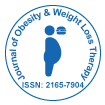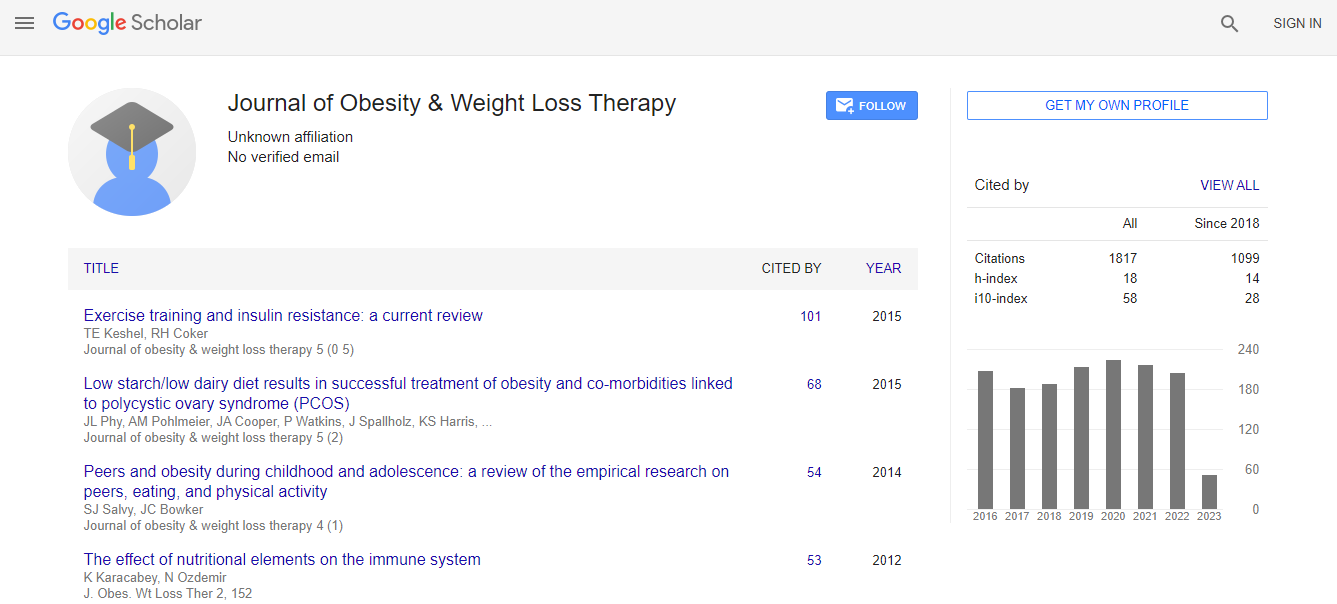Our Group organises 3000+ Global Conferenceseries Events every year across USA, Europe & Asia with support from 1000 more scientific Societies and Publishes 700+ Open Access Journals which contains over 50000 eminent personalities, reputed scientists as editorial board members.
Open Access Journals gaining more Readers and Citations
700 Journals and 15,000,000 Readers Each Journal is getting 25,000+ Readers
Google Scholar citation report
Citations : 2305
Journal of Obesity & Weight Loss Therapy received 2305 citations as per Google Scholar report
Journal of Obesity & Weight Loss Therapy peer review process verified at publons
Indexed In
- Index Copernicus
- Google Scholar
- Open J Gate
- Genamics JournalSeek
- Centre for Agriculture and Biosciences International (CABI)
- RefSeek
- Hamdard University
- EBSCO A-Z
- OCLC- WorldCat
- SWB online catalog
- CABI full text
- Cab direct
- Publons
- Geneva Foundation for Medical Education and Research
- Euro Pub
- University of Bristol
- Pubmed
- ICMJE
Useful Links
Recommended Journals
Related Subjects
Share This Page
FMT reduces the mortality of BALB/c mice caused by Listeria monocytogenes (EGD-e) infection
17th International Conference on Obesity, Diet and Nutrition
Qing Liu and Liang Guo
University of Shanghai for Science and Technology, China
Posters & Accepted Abstracts: J Obes Weight Loss Ther
Abstract
Listeria monocytogenes (Lm) is a kind of food pathogenic bacteria with strong pathogenicity that has been shown previously to cause infection via the gastrointestinal (GI) tract. External pathogens can cause changes in gut microbiota, and such a change can promote or confer resistance to the infection of pathogenic bacteria. However, the changes in the microbiota during Lm through the GI tract and infect the body is unknown. Eight-week-old mice’s were inoculated orally with L. monocytogenes EGD-e, and portions of the liver, spleen and cecal contents were removed, homogenized and plated, and feces were collected on 0 day, first day and third day. After that, different concentrations of FMT were used to treat Lm infected mice. L. monocytogenes culture confirmed that the content of Lm in cecum after intragastric inoculation reached the highest level on first day, and then remained at a low level. The content of Lm in spleen and liver reached the highest level on third day. The percentage of the Proteobacteria spp, Bacteroidetes and Cyanobacteria on first day remained significantly higher than that of the 0 day (P<0.01), while the proportion of Lactobacillus and Staphylococcus on first day was significantly lower than that of the 0 day (P<0.01). Compared to first day, the Coprococcus, Blautia and Eubacterium increased significantly on third day. In addition, the mortality of infected mice was reduced by 28% after FMT treatment compared with PBS treatment. Finally, we showed that inoculated with EGD-e significantly altered the gut microbiome in mice in different times and the potential probiotics increased in infected mice like the Blautia may be developed as new probiotics to enhance resistance against L. monocytogenes infections. The gut microbiome of healthy mice can significantly reduce the mortality of infected mice by reducing the inflammatory response and rebuilding the dysbacteriosis.Biography
Qing Liu is a Director of institute for foodbone pathogen harmfuless and management school of medical instrument and food engnieering and Professor at Univercity of Shanghai for Science and Technology, China
E-mail: liuq@usst.edu.cn

 Spanish
Spanish  Chinese
Chinese  Russian
Russian  German
German  French
French  Japanese
Japanese  Portuguese
Portuguese  Hindi
Hindi 
